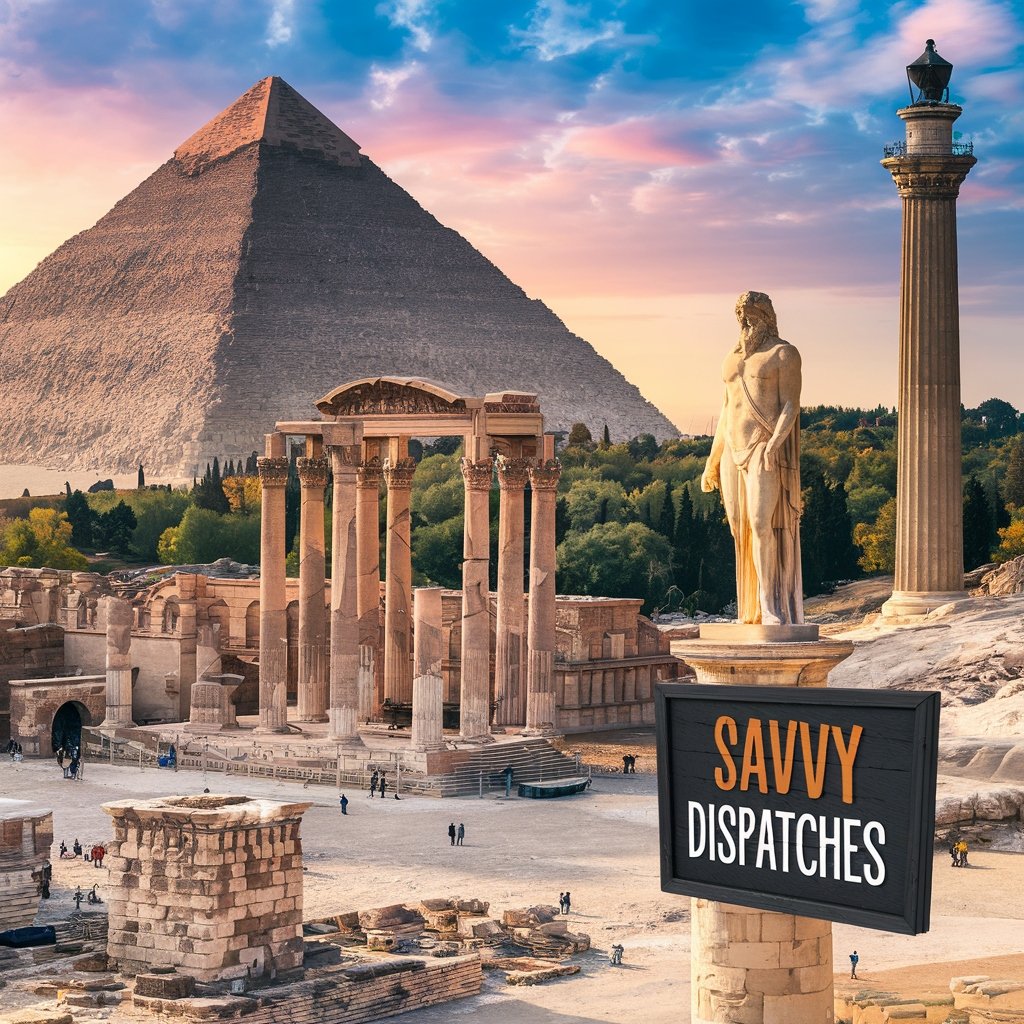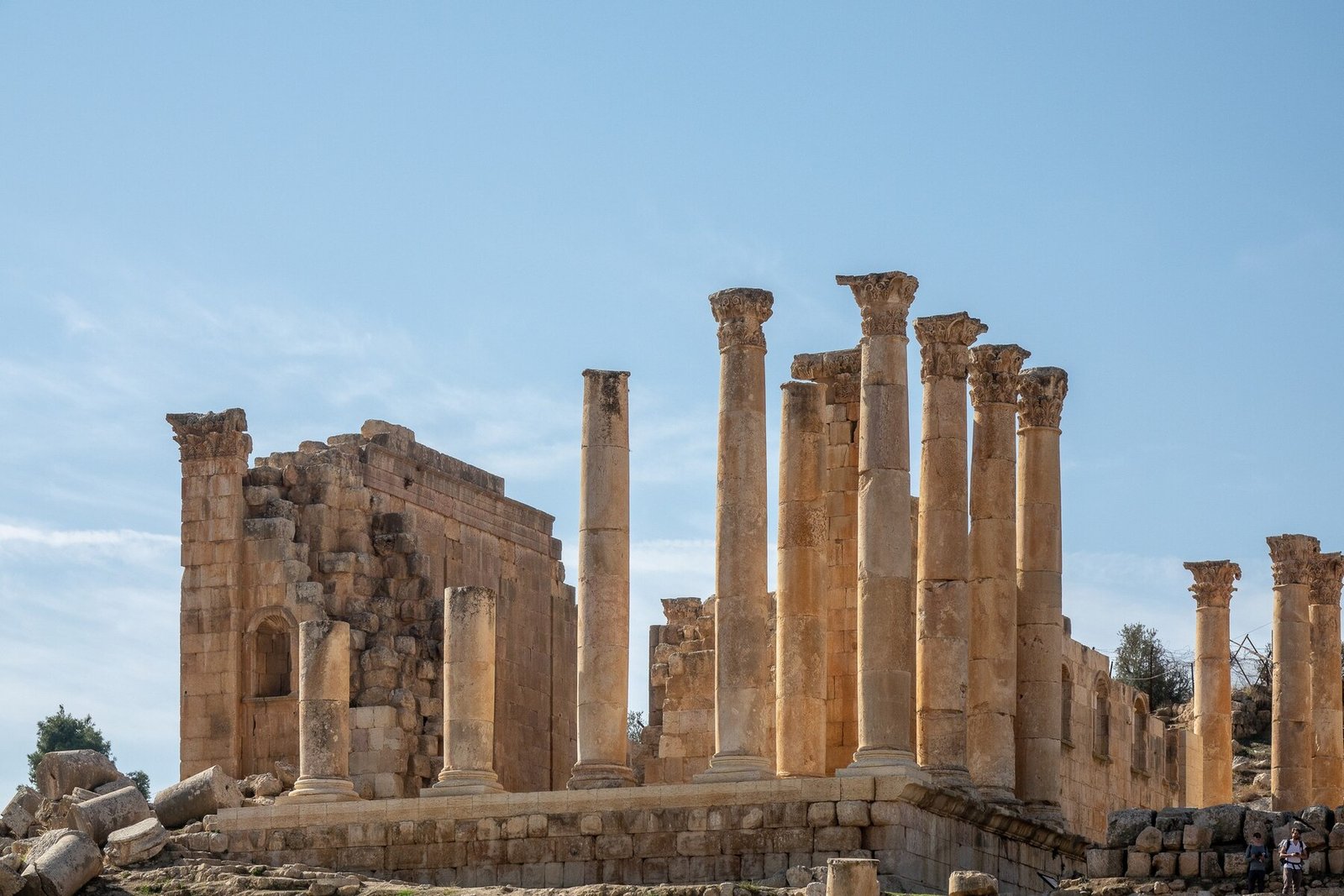Travel
7 Wonders of the World That Will Leave You in Awe!

Throughout history, humanity has created incredible structures that showcase our ingenuity and artistic expression. Among these masterpieces, the 7 Wonders of the World are iconic symbols of human achievement. Each wonder tells a story of ambition, culture, and craftsmanship that transcends time. As you explore these extraordinary sites, you’ll find yourself captivated by their beauty and the mysteries they hold. Join us on a journey to uncover these remarkable wonders that continue to inspire awe in people around the globe!
What Are the 7 Wonders of the World?
The 7 Wonders of the World capture humanity’s creative spirit and architectural brilliance. These remarkable feats showcase the ingenuity of ancient civilizations.
Each wonder tells a story, reflecting cultural values and technological advancements of its time. They span various regions, from Egypt to Greece, highlighting diverse historical contexts.
These wonders are not just structures; they represent human ambition. Generations have gazed at them in awe, drawn by their beauty and significance.
Despite the passage of time, these landmarks continue to inspire travelers and historians alike. Their legacies endure through stories passed down over centuries.
Exploring these wonders ignites curiosity about our past. Each site invites us to ponder how such extraordinary creations were brought to life with limited resources.
The Great Pyramid of Giza

Pyramid of Giza – Source: FreePik
The Great Pyramid of Giza stands as a timeless symbol of ancient engineering. Constructed around 2580–2560 BC, it is the oldest and largest of the three pyramids in Egypt’s Giza complex.
This architectural marvel was originally built for Pharaoh Khufu. Its precise alignment with the cardinal points reflects an impressive understanding of astronomy by its creators.
Comprising approximately 2.3 million blocks of stone, each weighing between 2 to 30 tons, the sheer scale is mind-boggling. Imagine how many workers toiled for decades to complete this monumental structure!
Visitors today are captivated by its grandeur and mystery. Many questions remain about how such precision was achieved without modern technology. The pyramid not only serves as a tomb but also continues to inspire awe and curiosity across generations.
Hanging Gardens of Babylon

Hanging Gardens of Babylon – Source: Blender Artists
The Hanging Gardens of Babylon are shrouded in mystery and legend. Often regarded as one of the most remarkable feats of ancient engineering, these gardens were said to be a breathtaking series of terraces brimming with lush greenery and vibrant flowers.
Located in the heart of Babylon, they supposedly floated above the city like an emerald oasis. The gardens were attributed to King Nebuchadnezzar II, who built them for his wife, Amytis. She longed for the verdant hills and mountains of her homeland.
Descriptions from ancient texts paint a vivid picture: cascading plants that draped elegantly over multi-tiered structures. Water was thought to flow through intricate irrigation systems, bringing life to each layer.
Despite extensive historical writings about their existence, some debate whether they ever truly existed or if they are merely a poetic symbol of human ambition and beauty.
Statue of Zeus at Olympia

Statue of Zeus at Olympia – Source: 7Wonders.org
The Statue of Zeus at Olympia was a monumental masterpiece crafted by the renowned sculptor Phidias around 435 BC. This colossal figure stood approximately 12 meters tall, towering over visitors in its temple.
Made of ivory and gold-plated bronze, it depicted the king of the Greek gods seated on an ornate throne. The craftsmanship showcased intricate details, from his flowing robes to the symbolic items in his hands—a scepter and a statue of Nike, representing victory.
This wonder wasn’t just art; it embodied religious significance for ancient Greeks who traveled far and wide to worship at Olympia. The statue served as both a tribute to Zeus and a symbol of power during the Olympic Games held nearby.
Sadly, this incredible creation no longer exists. It was lost to history after being moved multiple times before ultimately perishing in a fire. Yet its legacy continues to inspire awe today.
Temple of Artemis at Ephesus

Temple of Artemis at Ephesus – Source: FreePik
The Temple of Artemis at Ephesus was a marvel of ancient architecture. Constructed around 550 BC, it stood as one of the largest temples in the ancient world.
Dedicated to the goddess Artemis, this temple symbolized prosperity and devotion. Its grand columns soared high into the sky, showcasing intricate carvings that depicted various mythological scenes.
Visitors from far and wide were drawn to its beauty and significance. They came not only for worship but also to admire its stunning design.
Unfortunately, like many wonders, it faced destruction over time. Various invasions led to its eventual ruin. Despite this, stories of its grandeur continue to inspire people today.
Artemis’s temple remains a testament to human creativity and ambition. Though only remnants exist now, imagination fills in what once was—a glorious sanctuary dedicated to a powerful deity.
Mausoleum at Halicarnassus

Mausoleum at Halicarnassus – Source: unmuseum.org
The Mausoleum at Halicarnassus was a grand tomb built for Mausolus, a Persian satrap. This remarkable structure stood in what is now Bodrum, Turkey, and it showcased the artistry of ancient Greek architects.
Standing at approximately 45 meters high, the mausoleum combined elements from various architectural styles. Its design featured an impressive mix of Greek, Egyptian, and Lycian influences. The result was nothing short of breathtaking.
Adorned with intricate sculptures and reliefs created by renowned artists of the time, it celebrated both life and death. Each detail told a story about love and reverence for its inhabitants.
Sadly, much like other wonders, this masterpiece succumbed to natural disasters over centuries. Yet its legacy continues to inspire awe today. Visitors often reflect on what once stood as one of the tallest structures in the world—an everlasting testament to human creativity.
Colossus of Rhodes

Colossus of Rhodes – Source: Britannica
The Colossus of Rhodes was an awe-inspiring statue that once stood at the entrance of the harbor in Rhodes, Greece. Erected around 280 BC, this gigantic figure depicted Helios, the sun god. Crafted by the sculptor Chares of Lindos, it towered approximately 33 meters high.
Constructed using bronze plates over a stone framework, its sheer scale and artistry captured imaginations for centuries. Sailors approaching the island would have been met with this colossal symbol of victory and unity after a successful defense against invaders.
Sadly, an earthquake struck in 226 BC, toppling this magnificent wonder to the ground. Even though it no longer stands today, stories about its grandeur continue to inspire travelers and historians alike.
The Colossus not only represented engineering prowess but also reflected cultural significance during its time—a testament to human creativity and ambition that still resonates throughout history.
Lighthouse of Alexandria

Lighthouse of Alexandria – Source: FreePik
The Lighthouse of Alexandria, known as the Pharos of Alexandria, was a marvel of engineering in the ancient world. Erected on the small island of Pharos around 280 BC, it guided sailors safely to shore with its towering height and brilliant light.
Standing approximately 100 meters tall, this architectural wonder featured three distinct tiers: a square base, a middle octagonal section, and a circular crown topped with a statue. The design showcased not just aesthetic beauty but also innovative construction techniques for its time.
Its enormous flame atop the lighthouse could be seen from miles away. This beacon wasn’t just practical; it symbolized safety and hope for those at sea.
Sadly, after enduring earthquakes over centuries, this iconic structure fell into ruin. Yet today, its legacy continues to inspire architects and dreamers alike.
Why Do the 7 Wonders Still Matter Today?
The 7 Wonders of the World captivate our imagination even today. They remind us of the incredible feats humanity can achieve. Each wonder tells a story of ambition, creativity, and cultural significance.
These ancient structures connect us to our past. They spark curiosity about civilizations long gone and inspire exploration of their legacies. The knowledge encapsulated in these wonders invites deeper understanding.
In an age dominated by technology, they stand as testaments to human ingenuity without modern tools. This inspires innovation and reminds us that greatness often arises from determination and passion.
Additionally, these wonders unite people across cultures. Travelers flock from all corners of the globe to witness them firsthand, creating shared experiences that transcend language barriers.
Their continued relevance lies not just in history but also in what they represent: hope, resilience, and a relentless quest for beauty amidst impermanence.
Conclusion
The 7 Wonders of the World continue to capture our imagination and inspire wanderlust. Each site tells a story, showcasing the ingenuity and creativity of ancient civilizations. They remind us of humanity’s ability to create something truly remarkable.
Visiting these wonders offers a glimpse into history, culture, and art that transcends time. Whether you’re an avid traveler or simply someone who appreciates beauty, there’s no denying the impact these structures have on our world today.
Their significance stretches beyond their physical presence; they embody dreams, aspirations, and the relentless pursuit of greatness. As we explore them through stories or firsthand experiences, we connect with generations past while envisioning what future wonders might emerge. The journey is as important as the destination when it comes to celebrating these monumental achievements.
Guides
Simbramento: A Hidden Gem for Adventurous Travelers

Nestled in the heart of Italy, Simbramento is a hidden gem that beckons adventurous travelers seeking authentic experiences. This picturesque village, with its charming streets and breathtaking landscapes, offers a unique blend of history, culture, and outdoor adventures. Unlike tourist hotspots that often feel crowded and commercialized, Simbramento invites you to explore its rich heritage and natural beauty at your own pace. Discover why this enchanting destination is becoming a must-visit for those eager to uncover the secrets of Italy’s lesser-known treasures. Whether you’re hiking through lush hills or savoring local delicacies, Simbramento promises an unforgettable journey filled with discovery. Grab your gear; it’s time to embark on an adventure like no other!
What is Simbramento?
Simbramento is a quaint village located in the stunning region of Abruzzo, Italy. Tucked away amidst rolling hills and lush greenery, it offers a picturesque setting that feels untouched by time. With its narrow cobblestone streets and charming stone houses, Simbramento exudes an old-world charm that enchants visitors.
The village is known for its serene atmosphere and friendly locals who take pride in their heritage. Here, life moves at a leisurely pace, allowing travelers to fully absorb the beauty around them.
Nature lovers will find plenty to admire in the surrounding landscapes filled with forests and mountains. The air is fresh, making it ideal for hiking or simply enjoying quiet moments outdoors.
Art enthusiasts can also appreciate local craftsmanship showcased through traditional buildings adorned with intricate details reflecting the area’s rich history. Simbramento invites you to explore its hidden corners while creating lasting memories along the way.
The History and Culture of Simbramento
Simbramento, nestled in the heart of Italy, boasts a rich tapestry of history. Its origins date back to ancient times when it served as an important settlement for various civilizations.
The town showcases medieval architecture, with stone houses and narrow alleys that whisper tales of yesteryears. The remnants of old castles stand proudly on hilltops, offering stunning views over the landscape.
Culturally, Simbramento is a melting pot. Festivals celebrating local traditions fill the calendar year-round. Visitors can immerse themselves in vibrant music and dance that echo through its streets.
Artisans still practice age-old crafts here. Pottery and textiles reflect both heritage and creativity unique to this region.
Every corner invites exploration while weaving stories of resilience and charm into the lives touched by Simbramento’s allure.
Outdoor Activities in Simbramento
Simbramento is a paradise for outdoor enthusiasts. The rolling hills and lush landscapes create the perfect backdrop for hiking, biking, and nature walks.
For hikers, trails vary from easy strolls to challenging routes that lead to breathtaking viewpoints. Each turn reveals stunning vistas of the Italian countryside.
Cycling here is equally exhilarating. Rent a bike and explore winding paths that take you through charming villages and serene fields filled with wildflowers.
Adventure seekers can try rock climbing on nearby cliffs or embark on thrilling zip-lining experiences that provide an adrenaline rush like no other.
Don’t forget about water sports! Canoeing or kayaking in local rivers offers both relaxation and adventure as you paddle along picturesque waterways surrounded by nature’s beauty.
Whether you’re seeking tranquility or excitement, Simbramento has something to satisfy every adventurous spirit looking to connect with the great outdoors.
Local Cuisine and Dining Options
Simbramento is a delight for food lovers. The local cuisine reflects the rich agricultural heritage of the region. Fresh ingredients are at the heart of every dish, making each bite a true taste of Italy.
Don’t miss out on trying “Caciocavallo,” a traditional cheese that pairs beautifully with locally produced wines. Expect hearty pasta dishes made from scratch, often served with seasonal vegetables or meat sauces that burst with flavor.
For those seeking something sweet, “Pigna” is an unforgettable treat. This festive cake combines nuts and dried fruits, embodying the essence of Simbramento’s culinary traditions.
Dining options range from cozy trattorias to family-run osterias, where locals gather to share stories over delicious meals. Each establishment offers its own spin on classic recipes, ensuring a unique experience every time you dine out in this charming town.
Unique Accommodation Options in Simbramento
Simbramento offers a variety of unique accommodation options that elevate your travel experience. Picture waking up in a beautifully restored medieval villa, surrounded by stunning landscapes and rich history.
For those seeking something different, consider staying in a charming agriturismo. These working farms allow you to immerse yourself in the local culture while enjoying fresh produce straight from the source.
Alternatively, cozy bed-and-breakfasts dot the countryside. They provide warmth and personal touches that larger hotels often lack. Here, you’re likely to share stories with welcoming hosts over delicious homemade breakfasts featuring regional specialties.
If you’re after adventure, seek out rustic cabins tucked away in nature. These spots offer tranquility and breathtaking views, perfect for unwinding after a day of exploration.
No matter where you choose to stay in Simbramento, each option promises an authentic slice of Italian life just waiting to be discovered.
Exploring the Surrounding Areas
Venture beyond Simbramento to uncover a tapestry of breathtaking landscapes and charming villages. The nearby Monti Sibillini National Park offers endless hiking trails, where you can lose yourself in nature’s beauty.
Visit Castelluccio di Norcia, famous for its stunning flower fields that bloom vibrantly in spring. It’s an excellent spot for photography enthusiasts and nature lovers alike.
Another gem is the historic town of Norcia. Renowned for its culinary delights, this area boasts mouthwatering cured meats and cheeses. Take time to savor local flavors while soaking up the lively atmosphere.
For those who enjoy adventure, the nearby Valnerina river beckons with opportunities for rafting and kayaking. Whether you’re an adrenaline junkie or seeking tranquil moments, these surroundings cater to all preferences.
Don’t miss the chance to explore hidden paths leading to ancient ruins or picturesque viewpoints offering panoramic vistas that simply take your breath away.
Tips for Traveling to Simbramento
When planning your trip to Simbramento, pack for varying weather. The region experiences distinct seasons, so layers are key.
Public transport is limited but provides a scenic way to explore nearby villages. Renting a bike can also be an exhilarating option for the adventurous traveler.
Engage with locals; they often have invaluable insights and hidden spots that aren’t in guidebooks. A simple greeting in Italian goes a long way.
Learn a few phrases before you arrive. It shows respect and enriches your experience with deeper cultural connections.
Timing matters too—visit during off-peak months for fewer crowds and more personal interactions. Don’t forget comfortable walking shoes; the cobblestone streets invite exploration at every turn.
Keep an open mind and embrace spontaneity. Some of the best adventures arise from unexpected detours or local recommendations!
Conclusion
Simbramento is a destination that beckons adventurous travelers with its unique charm and untamed beauty. From its rich history to the vibrant local culture, this hidden gem offers experiences that are both memorable and immersive. The myriad of outdoor activities available ensures there’s something for everyone, whether you’re hiking through breathtaking landscapes or indulging in thrilling water sports.
Food lovers will find delight in Simbramento’s local cuisine, which features fresh ingredients and traditional recipes passed down through generations. Dining options range from cozy family-run eateries to more upscale restaurants, each offering a taste of the region’s culinary heritage.
Accommodation options in Simbramento provide a variety of choices to suit different preferences and budgets. Whether you prefer staying in quaint bed-and-breakfasts or unique lodges tucked away in nature, you’ll find the perfect place to rest your head after a day filled with adventure.
Exploring the surrounding areas also adds depth to your journey. Nearby towns boast historical landmarks and stunning vistas that complement everything Simbramento has to offer.
With these insights, it’s clear why Simbramento deserves a spot on any travel itinerary for those seeking an authentic experience off the beaten path. Embrace the adventure waiting for you here—discovering every corner of this picturesque location might just reveal your new favorite getaway.
Food
The Complete Guide to Black Caviar: Understanding Quality, Origin & Flavor Profiles

Few gourmet delicacies in the world evoke the same level of prestige, refinement, and culinary fascination as black caviar. From royal banquets to Michelin-starred restaurants, caviar has long been associated with luxury dining and impeccable craftsmanship. Today, more consumers than ever are seeking transparent sourcing, sustainable farming, and authentic flavor — qualities exemplified by leading producers such as Tsar Caviar.
For those wishing to explore premium selections or order directly from artisanal suppliers, visit Tsar Caviar.
In this comprehensive guide, we dive into the origins, production methods, tasting notes, and shopping considerations surrounding modern caviar. Whether you’re new to the world of sturgeon roe or a seasoned gourmet, this article provides clear insights to help you navigate the market with confidence
What Makes Tsar Caviar Exceptional | tsar caviar
The global market for caviar has shifted dramatically in the last decade. While wild Caspian sturgeon once dominated supply, responsible aquaculture now defines the highest standards of quality. Tsar Caviar represents a unique combination of heritage, authenticity, and modern traceability.
Founded by Oleg Sanzyapov in 2014, the brand maintains direct relationships with sustainable farms worldwide. What sets Tsar Caviar apart is its exclusive cooperation with a rare Caspian Sea farm, where fish are raised in near-wild saltwater conditions and fed natural seasonal diets. This approach results in roe with exceptional purity, firm texture, and rich, nuanced salinity.
Every batch is hand-selected, traditionally salted, and inspected to ensure freshness, consistency, and depth of flavor. The result is caviar that honors centuries-old methods while meeting the expectations of today’s discerning clientele.
How to Choose the Right Caviar
For those looking to buy black caviar, understanding product differences is essential. Although varieties may look similar at first glance, each has its own character shaped by species, diet, environment, and curing method.
Here are key factors buyers should consider:
Species
Siberian Sturgeon, Kaluga, Sterlet, and Hackleback are some of the most common types. Each produces eggs with distinct flavors, ranging from buttery and mild to deep and oceanic.
Texture
High-quality roe should feel firm yet delicate, with a clean pop and no mushiness.
Aroma
Fresh caviar carries subtle marine notes, never overly fishy or metallic.
Color
From charcoal gray to jet-black, color often reflects species variation rather than quality.
Salting Method
Traditional malossol (low-salt) techniques highlight natural flavor and purity.
Consumers who wish to buy black caviar online should seek suppliers that guarantee freshness, sustainable sourcing, and temperature-controlled shipping — all essential for preserving quality.
Exploring One of the Rarest Varieties
Among luxury selections, black pearl caviar stands out for its visual appeal and refined taste. Known for its smooth finish, glossy dark pearls, and subtle minerality, this variety appeals to both experienced gourmets and newcomers.
Black pearl caviar is often praised for:
- Elegant, uniform grain size
- Balanced brine levels
- Nutty or creamy undertones
- Sophisticated presentation suitable for high-end dining
This type is frequently featured in tasting menus, caviar flights, and premium gift sets.
How True Caviar Is Produced
High-quality caviar requires expertise at every stage:
- Selective breeding and sustainable farming
Fish are raised in clean, carefully monitored water systems that mimic natural environments. - Natural feeding
Many premium suppliers use seasonal diets or wild-caught feed to enhance flavor integrity. - Harvesting at optimal maturity
Eggs are collected when texture and size reach peak quality. - Traditional hand-salting
Minimal salt is used to preserve natural taste while ensuring shelf stability. - Batch inspection
Top producers — including Tsar Caviar — check every new batch for consistency and freshness.
This combination of craftsmanship and science results in exceptional black caviar worthy of gourmet experiences.
Serving & Pairing Recommendations
Caviar is best enjoyed chilled and served with minimal enhancement. Here are classic and modern pairings:
- Blinis with crème fraîche
- Butter-toasted brioche
- Soft-boiled quail eggs
- Mild cheeses
- Champagne, Crémant, or ice-cold vodka
Avoid overly salty or spicy foods that can overpower the delicate pearls.
Why Gourmet Consumers Prefer Responsible Producers
Ethics and sustainability now play a major role in luxury food industries. Consumers increasingly choose producers who prioritize:
- Transparent sourcing
- Environmentally responsible aquaculture
- Non-additive salting methods
- Temperature-controlled shipping
- Quality-over-quantity harvesting practices
This is one reason premium suppliers like Tsar Caviar stand out in the modern market.
Popular Uses for Premium Caviar
Beyond traditional tasting, caviar is now featured in:
- Fine-dining appetizers
- Seafood towers
- Holiday gift boxes
- Corporate luxury gifts
- Home gourmet experiences
- Catering for weddings and high-end events
Its versatility and prestige make it suitable for any celebration.
Frequently Asked Questions
What is the best type of caviar for beginners?
Siberian Sturgeon and Hackleback are smooth, balanced, and easy to appreciate.
Why is black caviar considered a luxury product?
It requires long maturation periods, artisanal processing, and careful preservation.
Where can I buy authentic premium caviar?
Trusted suppliers like Tsar Caviar offer guaranteed freshness and sustainable sourcing — visit https://tsarcaviar.com/.
Is caviar healthy?
Yes. Caviar is rich in Omega-3 fatty acids, vitamins, and high-quality protein.
How should caviar be stored?
Keep unopened tins refrigerated at 28–32°F. Consume shortly after opening for ideal texture and taste.
Guides
Top 10 Best Beaches in Florida You Need to See

Florida is a sun-soaked paradise that beckons beach lovers from all corners of the globe. Best Beaches in Florida with warm, turquoise waters and powdery white sand, it’s no wonder this state is often dubbed the ultimate beach destination. Whether you’re looking to soak up some rays, surf the waves, or take a leisurely stroll along the shore, Florida has something for everyone.
From bustling beaches packed with activities to serene spots where you can unwind in peace, there’s an array of choices that cater to every type of traveler. But with so many stunning options available, how do you know which ones are truly worth your time? That’s where we come in! Let’s dive into our list of the best beaches in Florida that deserve a spot on your travel itinerary. Get ready to discover some hidden gems and popular hotspots that will leave you dreaming about sandy shores and sunsets for years to come!
Florida: The Ultimate Beach Destination
Florida is often referred to as the Sunshine State, and for good reason. Its balmy climate makes it a year-round beach haven. With over 800 miles of coastline, there’s no shortage of stunning shores to explore.
Each beach offers its unique charm, from vibrant nightlife at South Beach to the tranquil vibes of Sanibel Island. Families flock to kid-friendly spots like Cocoa Beach, while couples seek romantic sunsets along Naples Pier.
Wildlife enthusiasts can enjoy the natural beauty found in state parks like Grayton Beach. Here, you might spot dolphins playing just off the coast or sea turtles nesting on sandy dunes.
Adventure-seekers can try their hand at paddleboarding or snorkeling in crystal-clear waters teeming with marine life. Florida truly caters to every kind of beachgoer, ensuring that your experience will be anything but ordinary.
Factors to Consider when Choosing a Beach in Florida
When selecting a beach in Florida, think about what you want from your experience. Are you looking for calm waters or exciting waves? Different beaches cater to different preferences.
Consider the amenities available. Some beaches are bustling with restaurants and shops, while others offer a more serene atmosphere with natural beauty.
Accessibility is another important factor. If you’re traveling with family or have mobility concerns, look for beaches that provide easy access and facilities like restrooms and parking.
Crowd levels can greatly influence your enjoyment. Popular spots might be packed during peak season; if you prefer solitude, seek out hidden gems along the coast.
Check local regulations regarding pets, alcohol, or activities like fishing and snorkeling to ensure they align with your plans for a perfect day at the beach.
Top 10 Best Beaches in Florida
Florida is a paradise for beach lovers. With its stunning coastline, each beach has its own unique charm.
Clearwater Beach
Clearwater Beach is a sun-seeker’s paradise. With its powdery white sand and shimmering turquoise waters, it’s no wonder travelers flock here year-round.
This beach boasts a vibrant atmosphere. Visitors can enjoy various water sports, from paddleboarding to jet skiing. The soft waves create the perfect playground for both kids and adults alike.
Stroll along the picturesque promenade lined with charming shops and restaurants. Grab a bite of fresh seafood or indulge in ice cream while soaking up the coastal breeze.
Don’t miss the stunning sunsets that paint the sky in brilliant hues of orange and pink each evening. It’s an experience you won’t want to forget.
For those seeking relaxation, plenty of shaded areas provide respite from the Florida sun. Whether you’re planning a family vacation or a romantic getaway, Clearwater Beach caters to all types of beach lovers.
Siesta Key Beach
Siesta Key Beach is a slice of paradise on Florida’s Gulf Coast. Known for its powdery white sand, it has consistently ranked among the best beaches in Florida.
The sand here is made up of 99% quartz, giving it that soft and cool feel underfoot. This unique composition not only enhances your beach experience but also reflects sunlight beautifully, keeping the area pleasantly bright.
Visitors flock to Siesta Key for its stunning sunsets. The shoreline provides the perfect vantage point to watch vibrant hues paint the sky as day turns into night.
With calm waters ideal for swimming and various water sports, it’s family-friendly too. Whether you’re building castles with kids or enjoying a peaceful stroll along the shore, there’s something magical about this beach that keeps people coming back year after year.
South Beach, Miami
South Beach, Miami is an iconic slice of paradise. Known for its vibrant nightlife and stunning Art Deco architecture, it draws visitors from around the globe.
The beach stretches along a beautiful coastline with powdery white sand and turquoise waters. It’s perfect for sunbathing or taking a leisurely stroll.
Beyond the beach, Ocean Drive buzzes with energy. Trendy restaurants and chic boutiques line the streets, offering delicious cuisine and unique shopping experiences.
You can also catch live music at various venues nearby. The cultural scene here is alive with art galleries showcasing local talent.
Water sports enthusiasts will find plenty to do too—jet skiing, paddleboarding, or simply enjoying a refreshing swim in the Atlantic Ocean makes every day exciting. South Beach truly encapsulates that quintessential Miami vibe you don’t want to miss out on during your Florida adventures!
Sanibel Island
Sanibel Island is a hidden gem in Florida’s treasure chest of beaches. Known for its stunning sunsets and serene atmosphere, it offers an escape from the hustle and bustle.
The island is famous for its shelling opportunities. Visitors often stroll along the shoreline collecting unique shells that wash ashore. Each find tells a story of nature’s artistry.
Nature lovers will appreciate the J.
N. “Ding” Darling National Wildlife Refuge located here. It’s a haven for birdwatchers and outdoor enthusiasts alike, with trails winding through lush landscapes.
Biking paths wind throughout Sanibel, making it easy to explore at your own pace. The island promotes eco-friendly practices, ensuring its natural beauty remains preserved for generations to come.
Dining options range from casual beachfront cafes to upscale eateries featuring fresh seafood. Enjoy local flavors while soaking in views of the Gulf Coast’s sparkling waters.
Cocoa Beach
Cocoa Beach is a paradise for surf enthusiasts and sun worshippers alike. With its soft, sandy shores stretching for miles, it invites visitors to relax or engage in thrilling water activities.
The beach is famous for its consistent waves, making it a hotspot for surfers of all skill levels. Whether you’re catching your first wave or honing advanced techniques, Cocoa Beach offers something for everyone.
Beyond the surf, check out the iconic Cocoa Beach Pier. This lively spot features restaurants and shops with stunning views over the Atlantic Ocean. It’s perfect for family outings or romantic sunsets.
Wildlife lovers will enjoy spotting sea turtles nesting along the shore during breeding season. Nature trails nearby offer glimpses of local flora and fauna too.
With vibrant nightlife options and charming beachside cafes, Cocoa Beach provides a well-rounded experience that caters to all tastes.
Pensacola Beach
Pensacola Beach is a hidden gem that boasts stunning white sand and turquoise waters. Nestled on the Gulf Coast, it’s a perfect spot for relaxation or adventure.
The beach stretches for miles, offering ample space to spread out. Whether you’re sunbathing with a good book or taking a beachside stroll, there’s something for everyone.
Water activities abound here. You can enjoy paddleboarding, kayaking, or even snorkeling around the nearby reefs. The vibrant marine life adds an exciting element to your underwater exploration.
History enthusiasts will appreciate Fort Pickens, which sits at one end of the beach. This historic site offers insight into the area’s military past while providing picturesque views of Pensacola Bay.
With plenty of dining options nearby, you can indulge in fresh seafood after a long day under the sun. Local restaurants serve up delicious dishes that highlight Florida’s culinary offerings.
Amelia Island
Amelia Island is a hidden gem tucked away in northeastern Florida. With its pristine shores and rich history, it offers an unforgettable escape from the ordinary.
The beach stretches for miles, inviting visitors to stroll along soft sands while enjoying stunning ocean views. The area boasts natural beauty and abundant wildlife, making it perfect for nature lovers.
Beyond the beaches, Amelia Island features charming historic districts filled with quaint shops and delicious eateries. You can explore Fort Clinch State Park or indulge in fresh seafood at local restaurants.
Don’t miss the chance to spot dolphins playing just offshore. The serene atmosphere makes this island feel like a world apart from bustling tourist spots.
Whether you’re sunbathing or exploring trails lined with ancient oaks, Amelia Island provides a refreshing mix of relaxation and adventure that captivates every visitor.
Naples Pier Beach
Naples Pier Beach is a hidden gem nestled along the Gulf of Mexico. This beach boasts soft white sands and stunning sunsets, making it ideal for leisurely strolls.
The iconic Naples Pier stretches out into the water, inviting visitors to fish or simply take in the panoramic views. It’s a popular spot for dolphin watching, adding an extra layer of excitement to your beach day.
Families flock to this location due to its gentle waves and calm atmosphere. Children can splash around while parents relax under swaying palm trees.
Nearby, lively restaurants offer fresh seafood that captures Florida’s coastal essence. Enjoying a meal with ocean vistas sets a perfect tone for any visit.
With ample parking and easy access, Naples Pier Beach combines convenience with breathtaking scenery. Whether you seek adventure or relaxation, this spot caters to all desires effortlessly.
St. Pete Beach
St. Pete Beach is a gem located on Florida’s Gulf Coast. This vibrant beach town offers soft, white sands that stretch for miles.
The atmosphere here is laid-back and welcoming. Visitors can enjoy an array of water sports or simply relax under the sun with a good book.
Sunsets at St. Pete Beach are legendary, painting the sky in stunning hues of orange and purple. The lively beachfront promenade features numerous restaurants, shops, and bars, creating a perfect blend of relaxation and entertainment.
Families will find plenty to keep everyone engaged—from volleyball games to paddleboarding adventures. For those seeking adventure beyond the shore, nearby Fort De Soto Park offers beautiful trails and kayaking opportunities in serene waters.
Whether you’re sipping cocktails at a beach bar or taking long walks along the shoreline, St. Pete Beach captures the essence of Florida’s coastal charm effortlessly.
Tips for Planning Your Trip to the Best Florida Beaches
When planning a trip to the best beaches in Florida, timing is everything. Visit during the shoulder seasons—late spring or early fall—for fewer crowds and pleasant weather.
Next, consider your beach activities. Are you looking for relaxation, water sports, or family fun? Each beach offers something unique. Research beforehand to find the perfect spot.
Accommodations vary widely. From beachfront resorts to cozy rentals, choose one that fits your budget and needs. Booking in advance can save you money and guarantee availability.
Don’t forget about local dining options! Fresh seafood shacks and fine dining are sprinkled throughout coastal towns. Trying local cuisine adds extra flavor to your trip.
Pack wisely! Sunscreen is a must along with hats and sunglasses for those sunny days on the sand. A beach chair or umbrella can also enhance your comfort while soaking up the sun.
Conclusion
Florida is a treasure trove of stunning beaches, each offering its unique charm and beauty. From the vibrant energy of South Beach to the serene shores of Sanibel Island, there’s a beach for every type of traveler. Whether you’re looking to relax under the sun or partake in thrilling watersports, these top 10 best beaches in Florida provide endless opportunities for fun and relaxation.
When planning your trip, consider what activities you enjoy most. If family-friendly environments are important, Cocoa Beach might be your best bet. For romantic getaways, Siesta Key offers breathtaking sunsets that will leave lasting memories.
With so many options available across this beautiful state, it’s easy to see why Florida consistently ranks as one of the top beach destinations worldwide. Pack your sunscreen and swimsuit; adventure awaits on Florida’s incredible shorelines!






